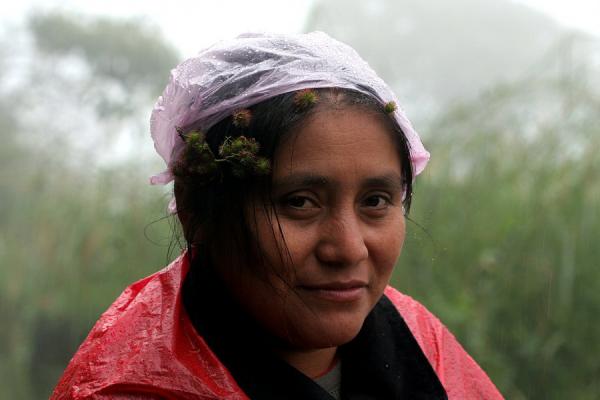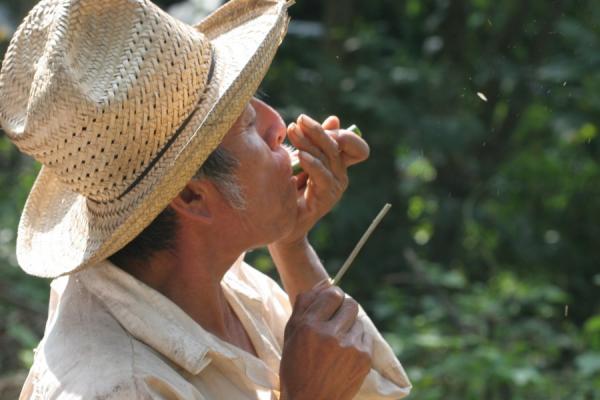NEH and NSF award more than $4 million to preserve nearly 40 languages

Woman demonstrating the origins of the Nahuat name for the burred plant Triumfetta grandiflora, called tsonsasal (tson= hair and sasal=stickly).
Jonathan Amith

Woman demonstrating the origins of the Nahuat name for the burred plant Triumfetta grandiflora, called tsonsasal (tson= hair and sasal=stickly).
Jonathan Amith
The National Endowment for the Humanities (NEH) and the National Science Foundation (NSF) recently announced 27 awards totaling more than $4 million in the 10th round of a joint effort to document languages threatened with extinction.
These new awards, part of an NSF-NEH Documenting Endangered Languages (DEL) program, support digital documentation work on nearly 40 endangered languages. They build research infrastructure, encourage long term collaboration with host countries and involve significant community engagement.
“Language is a source of invaluable cognitive, historical and environmental information,” said NSF Director France Córdova. “Most of what is known about human communication and cognition is based on less than 10 percent of the world’s 7,000 languages. We must do our best to document living endangered languages and their associated cultural and scientific information before they disappear."
New estimates from a three-year, NSF-supported study conclude that at least every three months somewhere in the world a language loses all its remaining speakers. The finding, based on newly compiled data, is an update from previous estimates that found at least one language goes extinct every two weeks.
Since the first round of awards DEL in 2005, the program has funded nearly 300 projects and more than 200 researchers who have captured high-quality data from languages in danger of extinction.
In this new round of awards, for example, DEL is funding the Advances in Linguistic, Ethnobotanical, and Botanical Sciences through Documentation of Traditional Ecological Knowledge project. Anthropologist Jonathan Amith of Gettysburg College in Pennsylvania and botanist John Kress of the Smithsonian Institution will examine the ways endangered languages encode information on how communities have historically interacted with their environments.
The study will provide clues about environmental changes over generations of speakers; it also will improve understanding about increases or decreases in biodiversity and sustainable practices adapted to particular environments.
Another project, Community Directed Audio-Visual Documentation of Ayöök, will create digital documentation of this Mixe-Zoquean language spoken in Mexico. Linguistic anthropologist Daniel Suslak of Indiana University and clinical psychologist Ben Levine, director of Speaking Place, will use an innovative technique called “facilitated-feedback filming” to stimulate groups of community members to recall long forgotten events, share ideas and engage in frank discussions.
The project will create a corpus of Ayöök language data. The interactive process will reawaken Ayöök traditional ecological knowledge that will be used by biochemists to expand maize genetics research at the Plant Sciences Department at the University of California, Davis.
“The NSF-NEH partnership to document endangered languages is making great strides,” said NEH Chairman William Adams. “Together, the two agencies are supporting research and creating valuable language resources that serve linguists and indigenous communities around the globe to revitalize their languages. And through its priority on Native American languages, NEH ensures the unique cultural and linguistic heritage of our own country is sustained.”
All of this year’s DEL projects will produce sophisticated digital products that can be publicly accessed through major language repositories such as the Archive of Indigenous Languages of Latin America, California Language Archive, the Endangered Language Archive at the School for African and Oriental Studies, and the Pacific and Regional Archive for Digital Sources in Endangered Cultures.
DEL projects continue to gain support across the National Science Foundation. Programs in Robust Intelligence, Linguistics, Cultural Anthropology, Polar Programs, International Science and Engineering, Experimental Program to Stimulate Competitive Research, Interdisciplinary Behavioral and Social Science Research, Science of Broadening Participation, and the Tribal Colleges and Universities Program support the 2014 awards.
At the National Endowment for the Humanities, DEL projects are funded through the Division of Preservation and Access and the Division of Research, where there continues to be a priority on documentation of languages of the Americas.
A complete listing of this year's awards follows.
Institutional Grants (awarded by NSF or NEH, as indicated):
- Jonathan D. Amith, Gettysburg College and Co-PI John Kress, Smithsonian Institution. Documenting Traditional Ecological Knowledge in the Sierra Nororiental de Puebla, Mexico, in Synchronic and Diachronic Perspectives, $449,942 (NSF) and $200,000 (NEH).
- Andrea Berez, University of Hawaii, Manoa, Making Pacific Language Materials Discoverable: Identifying and Describing Indigenous Languages, $122,317 (NEH)
- April Counceller and Co-PI Alisha S Drabek, Alutiiq Heritage Foundation. The Alutiq Language Archive and Speaker Registry, $399,058 (NSF).
- J. Andrew Cowell, University of Colorado at Boulder. Arapahoe (ARP) Lexical Database and Dictionary, $177,213 (NEH).
- Scott DeLancey, University of Oregon Eugene. Documenting the languages of Manipur: Clues to the prehistory of Sino-Tibetan languages, $312,722 (NSF).
- Christian T. DiCanio, Haskins Laboratories, Inc. Understanding Prosody and Tone Interactions through Documentation of Two Endangered Languages $340,456 (NSF).
- Jeffrey C. Good and Co-PI Jan Chomicki, SUNY at Buffalo. Language Documentation, Fieldwork Training Models, and Computational Tools for Understanding Linguistic Stability and Change, $406,186 (NSF).
- Lenore Grenoble, University of Chicago. Understanding spatial determiners, complex predicates, and case marking through traditional narratives in endangered languages, $239,955 (NSF).
- Jacob Manatowa-Bailey, Sac and Fox Nation of Oklahoma. Digitization, Transcription, and Publication of Sauk Narratives, $90,996 (NSF).
- Micheal Oltrogge and Co-PI Alice Saunsoci, Nebraska Indian Community College. Discovering Omaha Linguistic Structure through the Documentation of Fluent Omaha Elders' Voices, $85,568 (NSF).
- David Peterson, Dartmouth College. Documentation of Rengmitca (Tibeto-Burman), $175,635 (NSF).
- Clifton L Pye, University of Kansas Center for Research Inc., Procedures for the Rapid Documentation of Language Acquisition in an Endangered Language Context, $260,426 (NSF).
- Carmel O'Shannessy, University of Michigan Ann Arbor. Documentation and acquisition of Light Warlpiri and Warlpiri, $255,891 (NSF).
- Daniel F. Suslak, Indiana University and Co-PI Benjamin Levine of Speaking Place. Community Directed Audio-Visual Documentation of Ayook (ISO 939-3 MTO) and Development of an Online Ayook Language Portal, $258,316 (NEH).
Fellowships (awarded by NEH, $50,400 each):
- Emiliana Cruz, University of Massachusetts Amherst, Language Description: Chatino [ISO 693-3 CTP] place names and local knowledge: Description with a multimedia documentary corpus.
- Keri Eggleston, The Next Critical Step in Documenting Tlingit (TLI).
- Jeffrey E. Davis, University of Tennessee Knoxville, Plains Indian Sign Language (PSD) Digital Corpus Linguistics Project.
- John M. Keegan, Sara-Bagirmi Languages Database Project.
- Hiroko Sato, University of Hawaii, Preliminary field investigation of the Bebeli language (bek), Papua New Guinea.
Doctoral Dissertation Research Improvement Grants (awarded by NSF)
- Clare S. Sandy under the direction of Andrew J Garrett, University of California-Berkeley, The Phonology and Morphology of Karuk, $15,120.
- Lajos S Szoboszlai under the direction of Martha J. Macri, University of California-Davis, Mutsun reclamation continued: Three years in a learner's efforts to acquire language, $6,830.
- Adam J Tallman under the direction of Patience Epps, University of Texas at Austin, Investigating complex word reanalysis through endangered language data, $14,493.
Conferences and Workshops (awarded by NSF)
- Darryl Baldwin, Myaamia Center, Miami Tribe of Oklahoma, Archival Institute for Indigenous Languages, $167,650.
- Andrea Berez, University of Hawaii, WORKSHOP: Enriching Theory, Practice, and Application: Classes and Special Sessions at the 4th International Conference on Language Documentation & Conservation, $43,600
- Damir Cavar, Eastern Michigan University, 19th Lexical-Functional Grammar Conference, $12,199
- Jeffrey Good, SUNY at Buffalo, ComputEL: A workshop to explore the use of computational methods in the study of endangered languages, $25,007.
- Jason Kandybowicz and Co-PI Harold Torrence, University of Kansas Center for Research Inc., Africa's Endangered Languages: Documentary and Theoretical Approaches, $24,601.
----
The National Science Foundation is an independent federal agency that supports fundamental research and education across all fields of science and engineering. In fiscal year (FY) 2014, its budget is $7.2 billion. NSF funds reach all 50 states through grants to nearly 2,000 colleges, universities and other institutions. Each year, NSF receives about 50,000 competitive requests for funding and makes about 11,500 new funding awards. NSF also awards about $593 million in professional and service contracts yearly.

